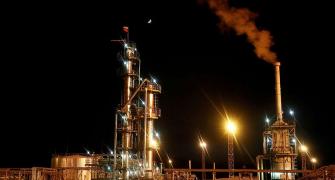The steel sector's fortunes are very closely linked with growth in the economy and industrial activities in the country. The consumption of steel in India and globally has been growing over decades except for a few years of economic slowdown. For, steel is the core sector of any economy, without which growth cannot be sustained.
 When India's economy should grow at eight per cent and more over the next several years, a humongous amount of money has to be invested into the infrastructure and construction sector. And, steel will play a key role.
When India's economy should grow at eight per cent and more over the next several years, a humongous amount of money has to be invested into the infrastructure and construction sector. And, steel will play a key role.
DEMAND
India's production has gone up from about 13 million tonnes in 1990 to 60 mt now and is further expected to reach 80 mt by the end of 2012. This is primarily due to domestic demand, helped by higher economic growth.
Steel is used in various industries. About 44 per cent of what is produced in India is used in construction and infrastructure. The automobile industry accounts for another 19 per cent and the rest is taken by consumer goods, engineering products, oil and gas, shipbuilding, etc. In India, most of what is produced is consumed in the domestic market.
There is more room for the sector to grow. India's per capita consumption is about 50 kg, compared to 200 kg in Japan, 320 kg in China, 500 kg in the UK. Our production is less than 10 per cent of China's annual output, of 600 mt. Our output is four to five percent of global steel production, of 1,300 mt, when we have 17 per cent of global population.
BUSINESS MODEL
A steel company's business structure is simple. A manufacturer will acquire raw material, namely iron ore and other valued added products, from the market or from their own captive mines, to be converted into steel and its different products. In this process, companies require a lot of coal to burn. So, there are two large components of manufacturing, iron ore and coal. Companies manufacture different varieties of steel, used in different industries -- flat products are used in automobiles and consumer goods, whereas long products are used in construction and other industries. Companies also manufacture speciality steel, used in industries such as engineering and infrastructure projects. Products which require more value addition in terms of durability, quality and other specification attract higher pricing, as in high-pressure pipes or cylinders.
INTEGRATION
Considering the uninterrupted requirement of raw material for making steel, integration is the most important part of any manufacturing. For every tonne of steel made, 1.5 tonnes of iron is required and over a tonne of coal. Some of the large companies like Tata Steel have their own mines but most do not and depend on the market for raw material
An increase in raw material prices raises the cost of manufacturing and, thus, leads to lower margins or losses for a non-integrated player, whereas integrated ones keep minting profits. In a downturn, when steel prices fall, non-integrated players find it difficult to produce steel, as their cost of production could be higher than market prices. In this situation, companies report lower capacity utilisation and losses, along with erosion in the operating and net profit margins. Thus, during downturn and upturn, looking at the capacity utilisation, an investor can understand the kind of revenue and profit growth the company could report. Higher capacity utilisation means better margins due to economics of scale. Sometimes, utilisation drops due to lower demand or due to new capacity addition which is not fully operational, which one should keep a watch on.
PRICING
Over a longer period of time, we will see that steel prices keep rising. It used to sell at Rs 4 a kg 20 years earlier; in 2008, it had become Rs 40 a kg. In this industry, prices fluctuate dramatically in the short term; after 2008, due to the global slowdown, steel prices fell to Rs 25 a kg. Steel is a global commodity; prices, to a large extent, depend on global demand and supply and factors such as global economic growth. Generally, during higher economic growth prices tend to increase significantly and in the downturn, fall drastically.
REALISATION
Realisations show how much a company gets for every tonne of steel sold. It fluctuates with the overall change in prices in the market. Realisation could be different for different companies, depending on the product and sales mix. If a company is having lower cost of production, higher realisations mean higher profits and higher operating margins.
VALUATION
To some extent, the industry is cyclical, with profits fluctuating due to changes in demand and supply, along with steel prices globally. Investors should be careful at the time of the peak in steel demand and pricing.
In most cases, the companies are valued based on the price-earnings multiple; however, this ratio should be carefully used, along with the growth in profit. Also, to check the valuations, one can look at ratios like EV/Ebitda and compare these with peer group companies and own historical valuations. And, during downturn, the companies trade at very depressed valuations because the fall in prices and volumes could have severe impact on the profits. At these times, the P/E ratio does not make sense and analysts use replacement cost to market cap and the price to book value.








